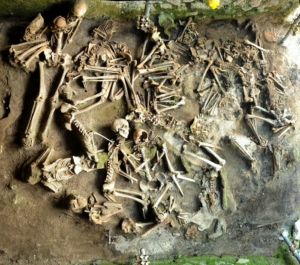
AMERICAN ASSOCIATION FOR THE ADVANCEMENT OF SCIENCE (AAAS)—Diets in the ancient Roman town of Herculaneum may have varied based on gender, with women eating more meat, eggs, and dairy and men eating more fish and cereals, according to an analysis of the remains of 17 adults who died in the Mount Vesuvius eruption of 79 CE. Silvia Soncin and colleagues suggest that these dietary differences reflect gender-based variations in food access, which may have stemmed from distinct occupations held by men and women, cultural prohibitions, or restrictions dictated by an uneven distribution of power. The authors note that the isotope analysis technique they used, combined with modeling, enabled them to reconstruct the citizens’ diets at unprecedented resolution and could transform research on prehistoric diets. While historical sources have implied that different demographics across ancient Roman society had access to different foods, scientists have lacked quantitative information to support this claim. To fill this research gap, Soncin et al. reconstructed the diets of 11 men and 6 women who died together at Herculaneum when Vesuvius erupted. These human remains offer a rare archaeological snapshot of an ancient population without biases, based on privilege and class, that can constrain information obtained from cemeteries. The researchers determined the stable isotope values of amino acids from bone collagen in the remains using compound-specific stable isotope analysis (CSIA), a technique that can illuminate dietary patterns with high resolution by revealing information often obscured in bulk stable isotope data sets. Soncin et al. measured the gender gap in marine protein consumption with greater precision than previous studies that used bulk isotope data, finding that men obtained 1.6 times more dietary protein from seafood than women did. They also estimated that the population of Herculaneum ate considerably more marine protein than Mediterranean populations in the mid- and late-20th century.
______________________________

View of skeletal remains in one of the vaulted chambers (fornici) during excavation. Luciano Fattore, Sapienza Università di Roma
______________________________
Article Source: Summary article by Shannon Kelleher, AMERICAN ASSOCIATION FOR THE ADVANCEMENT OF SCIENCE (AAAS)
______________________________
Advertisement





